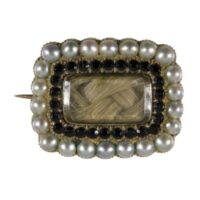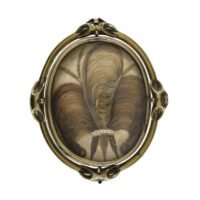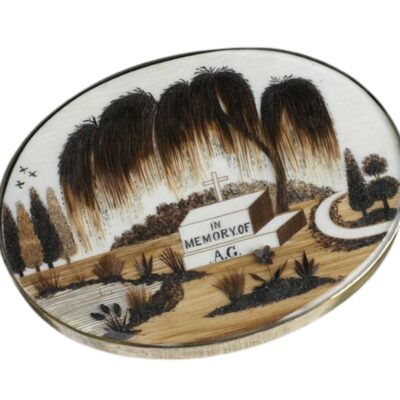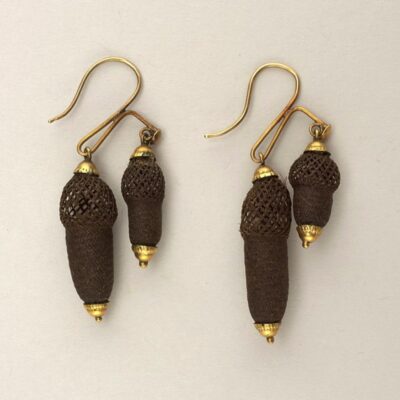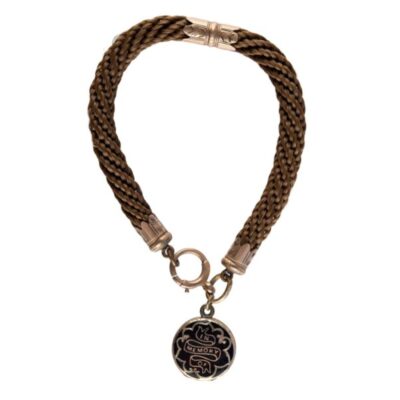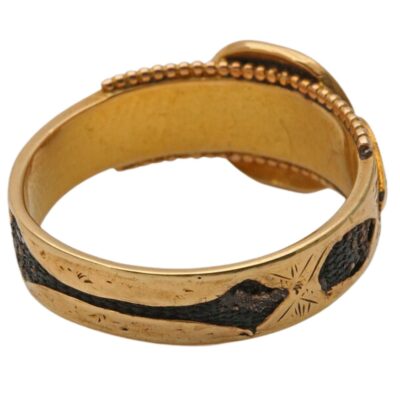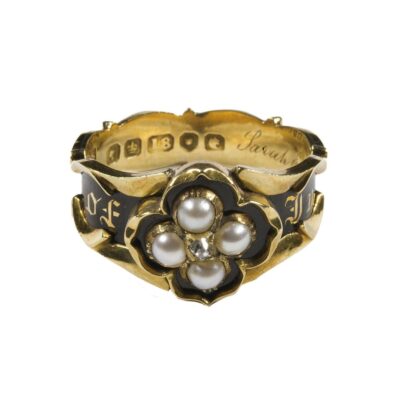英國倫敦T Cribb & Sons殯儀館於1881年創立,旗下「國家葬禮博物館」(National Funeral Museum)與《追新聞》聯乘,介紹英國傳統殯葬文化。
人們配戴珠寶首飾有不同理由:戒指、手鐲、頸鏈除了閃閃生輝外,同樣帶來情感抒發、護身符,或有幸運與智慧的象徵。在維多利亞時期的英國,珠寶也是一種表達哀悼之情,用來懷念失去的家人和摯愛,而他們會選用「頭髮」作為製作珠寶的主要材料。
歐洲的「悼念首飾」可追溯至中世紀,上流社會流行配戴骷髏、沙漏、死屍造型的飾物,令人連想到死亡(memento mori),拉丁文繙譯就是「勿忘死亡」、「記着你終有一死」。這些珠寶的設計就是要警醒世人:死亡是必然發生的。悼念珠寶經常鑲嵌罕有金屬或寶石,但為了反映人生衰亡,悼念首飾又要突顯基督信仰,表達現世很短暫,而最終追求的是來生。
因此,悼念珠寶在17世紀應運而生。當初只會把骷髏或骨頭作為裝飾,後來查理一世於1649年駕崩,英國君皇因叛國罪處死,其支持者配戴放有國皇肖像的掛墜或指環以作紀念。後來,悼念戒指成為上流社會喪禮的流行配飾。逝者更會在遺囑寫明,預留一筆遺產購買特別指環以送給親友紀念,當中刻有自己的名字、年齡和死忌,通常用黃金打造,配以搪瓷裝飾,親友會配戴至服喪期完結為止。
為甚麼「頭髮」成為悼念首飾時尚?主因是頭髮不易腐化,也十分容易處理,可以設計出不同的造型。互送一縷頭髮作為紀念,也流行了幾個世紀,而變成頭髮珠寶風行歐洲,則要等到18世紀的法國才獨領風騷。1700年代,歐洲風潮流行配戴假髮,在法國大革命後,民眾開始捨棄用真髮製造的假髮,令到假髮工匠另謀出路。當時就興起「頭髮藝術」,將頭髮融入珠寶設計內,或製作立體畫錶起來,作為家中的掛飾。
拿破崙時期的法國,囚犯將頭髮時尚帶到英國,在肯特郡Tunbridge Wells製作大量的頭髮珠寶,也引進法國設計和技術,頭髮首飾在20世紀初期開始風靡英國。
頭髮首飾最簡單的設計就是編織手鐲,還可以製作陀錶的吊鏈。另外,將頭髮磨碎融入顏料中,用幼細的筆創作微型畫,在首飾上繪上代表死亡的柳樹、骨灰盒、或哭泣的女人。當時,很多人不相信假髮工匠和珠寶商將他們出售的長髮,保證用來製作珠寶或紀念品悼念摯親,所以他們選擇在家自行製作,按照時尚婦女雜誌的指引,她們會用自己的頭髮用來製作刺繡、縫紉或編織紀念品。
與很多英國哀悼習俗一樣,頭髮首飾在20世紀初已不再流行,雖然仍有公司為逝者或至親頭髮製作珠寶,但英國人開始對配戴或接觸逝者遺物感到不舒服,開始改用骨灰製作不同的紀念品,將骨灰放入吊墜、指環或袖口鈕內。
倫敦國家葬禮博物館策展人
Minette Butler
(詳見【英文版】)
Mourning Mementos: A History of Hair Jewellery
People wear jewellery for many reasons. While pieces like rings, brooches and necklaces might be elaborate and shiny accessories, they can also be sentimental or used to bring protection, luck and wisdom. However, in Victorian Britain, jewellery was just another way to think and talk about death. People wore special “mourning jewellery” that was designed to commemorate lost family members or loved ones, often using what many might see as a gruesome and morbid material – real human hair.
- 胸針。(Credit:National Funeral Museum Collection 倫敦國家葬禮博物館收藏 )
- 胸針 Brooch (Credit:National Funeral Museum Collection 倫敦國家葬禮博物館收藏 )
European death jewellery dates back to mediaeval times, where the wealthy elite often wore pieces that depicted morbid images of skulls, hourglasses and corpses. These were commonly known as “Memento Mori” jewellery. Translating from Latin to mean “Remember Death” or “Remember You Must Die”, these jewels were designed to remind people of the realities and inevitability of death. Often made of precious metals and stones, they depicted gruesome images of death and decay. This represented the Christian belief that mortal life was temporary and that humanity’s real purpose was in the afterlife.
Mourning Jewellery began to appear in the late 17th century, where these depictions of skulls and bones developed into jewels designed to commemorate lost family and friends. These types of pieces may have been inspired by the death of King Charles I (1649), the only British monarch to be executed for treason whose supporters wore lockets and rings with his hidden portrait in his memory.
Mourning rings became a popular token at wealthy funerals. The dead would leave money in their wills to buy special rings to hand out to friends and family, engraved with their names, age and date of death. Usually made of gold and decorated with black or white enamel, they usually included tributes like “IN LOVING MEMORY” or “IN MEMORIAM”. These were worn by men and women even after mourning periods had finished.
These mourning rings encouraged other kinds of commemorative trinkets, particularly pieces known as “Sentimental Jewellery”. These jewels represented tokens of affection between friends, family and couples – especially after they had died. Though these pieces used all the same materials as before like gold, enamel, seed pearls and amethysts, they favoured one above all else – human hair.
Hair was popular for several reasons. The first is that it is one of the few types of human remains that does not decay, meaning it can be kept long after it is cut. It is also very easy to use. With the right tools and skills, even the smallest strands and locks of hair can be twisted, plaited or sewn. This means it can be used in lots of different designs and styles.
Locks of hair had long been a common gift exchanged between loved ones across the world for centuries. However, specially crafted hair jewellery became popular in Europe in the late 18th century, particularly in France. This was mainly due to changing fashions. In the 1700s, it was fashionable for the rich and elite to wear special powdered wigs made of real hair, often with elaborate styles and accessories. However, after the French Revolution, people abandoned these wigs for their natural hair, leaving many wig makers out of business and looking for new ways to use their skills. Hair art flourished both as jewellery and as framed decorative designs to hang on people’s walls and fireplaces, usually depicting three dimensional flowers and crosses.
Meanwhile, French prisoners of the Napoleonic wars helped import fashions for hair art to Britain, with a particular collection of prisoners stationed at Tunbridge Wells in Kent becoming famous for their frames and jewellery across the country. Bringing with them many French designs and techniques, the hair trade became an essential part of British fashion into the early 20th century.
There were lots of ways to make hair jewellery. The most popular was very similar to lace making, using special braiding tables that could loop and weave individual strands together in intricate patterns. The simplest designs were for bracelets, where hair was braided into ‘chains’ that could hang around wrists and be decorated with charms and decorative clasps.
These patterns could also be used to make ‘chains’ for pocket watches. More complicated designs could include making three dimensional hollow charms in the shapes of acorns, anchors and bows. These were very light and delicate, and were often used as dangling earrings or beautiful brooches that were pinned on ladies’ dresses.
Hair could also be shaped into elaborate patterns, often glued and pinned behind glass to be worn as brooches and charms. The pieces could be braided into thick plaits or spiralled into patterns similar to flowers and bunches of wheat. They often wove the locks of hair with gold or coloured thread for decoration. These jewels were often worn as cufflinks, bracelets and brooches.
The most beautiful pieces depicted ornate mourning scenes, often showing popular symbols of death and grief like . These were made by grinding hair into a fine powder and mixing them into paint, using very small brushes to create the miniature design. These were worn as brooches and other delicate charms.
However, many people did not trust the complex pieces made by specialist hair artisans. Some poorer people sold their long hair to wig makers and jewellers, and it was easier for artisans to use the often higher quality counterfeit material than the locks given by families.
This meant that many people worried that the jewellery they wore was not actually made from their loved one’s hair. This encouraged people to make their own jewellery at home, using patterns and instructions found in ladies magazines. Many women added hair art to their craft skills alongside embroidery, sewing and knitting.
Despite the clear skill and even beauty of some of these pieces, many may not understand why people enjoyed making and wearing hair jewellery. In the 19th century, people treasured this type of memento because it maintained a connection between themselves and their lost loved ones. These locks of hair may have been the only ‘piece’ of their families that they had left, especially before the invention and accessibility of photography. Most of these designs could use samples of hair from more than one person, keeping people close to all their friends and family at once – symbolically weaving them together.
It was also important that people could physically feel the hair, with some of the most popular designs making sure that the strands were woven into the band of a ring or as part of the chain on a necklace or bracelet. Being able to touch any part of their deceased family and friends was sentimental and comforting, creating contact between the living and the dead.
Like many British mourning customs, hair jewellery went out of fashion at the start of the 20th century. While there are still companies that offer to make jewellery from the hair of both living and dead loved ones, many in the UK are uncomfortable with the idea of wearing or touching pieces made from human remains. However, there are several growing businesses that make commemorative mementos using cremated ashes, often placing them in glass as charms, rings and cufflinks.
Minette Butler – Curator, National Funeral Museum
倫敦國家葬禮博物館(National Funeral Museum)
Twitter: @nfmtcribb
Instagram: @nationalfuneralmuseum
地址:T Cribb & Sons, Victoria House, Beckton, E6 5PA
開放時間:周一至五,上午9時至下午5時
歡迎團體或個人預約,館方安排免費導賞服務,請電郵至nfm@tcribb.co.uk

